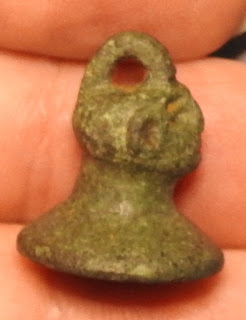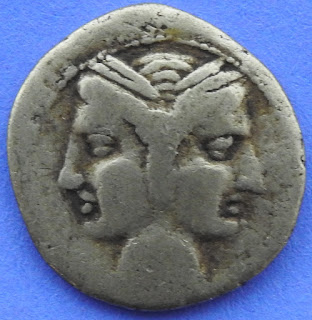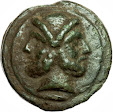Antiquities - Roman
Roman Cupid Steelyard Weight
1st-2nd century AD
A bronze steelyard weight comprising a length of trichinopoly chain with hook finial, and a hollow-formed bust of Cupid with small lateral wings to the shoulders, styled hair, wreath to the neck, small nose and pellet eyes.
78.5 grams; the weight is about 65 grams and the chain is about 12 grams
57 mm wing tip to wing tip
60.5 mm tall
22.4 mm thick
150 chain length
17.5 mm S loop
Condition - Fine
Provenance - Property of a British gentleman; formerly in the private collection of Russian businessman Yuri Golubev (1942-2007), some of his collection was published in his book 'Symbols and Images'; acquired on the London art market 1990s-2007.
Literature - Cf. Simpson, G. Roman Weapons, Tools, Bronze Equipment and Brooches from Neuss-Novesiaum Excavations 1955-1972, BAR International Series 862, Oxford, 2000 plate 48 for type.
See pictures from
the book by Simpson of a steelyard scale with a head of Bacchus below. Note the
scale below is larger: weight 2160 grams (about 20X) and height 115 mm (about
2X), or over 20 times heavier for 2 times the size. This is due to lead filling.
A second weight was listed as an Iron Age Celtic Steelyard Weight with Bust. This weight fits inside the Cupid weight.
Antiquities
- Celtic Iron Age
Iron
Age Celtic Steelyard Weight with Bust
1st
century BC-1st century AD
A
bronze weight with discoid base, shank formed as a crude male bust with loop
above.
16
grams
21.6
mm tall, including loop
18.4
X 19.3 mm base diameter, not quite circular
The
head is 10.7 mm wide and 12.3 mm from tip of nose to back of head
Condition
- Fine
Provenance
- Property of a British gentleman; formerly in the private collection of
Russian businessman Yuri Golubev (1942-2007), some of his collection was
published in his book 'Symbols and Images'; acquired by auction on 16 October
2006; accompanied by a copy of the listing.
The top left lead weight could be a fishing sinker, scale weight, plumb bob, loom weight or something else. My guess is loom weight.
The top middle, acorn shaped weight Acorn Weight is 46 X 15 mm and weighs 29 grams. It could be a plumb bob or steelyard scale weight. like the one below found near Cyprus.
The upper right weight has a geometric pattern, weighs 300+ grams and is 37 mm tall by 39 mm diameter. It has a bronze shell and lead filling.
The lower right weight has what looks like a portrait of a LRB (Late Roman Bronze coin). It weighs 380 grams and is 74 X 34 X 22
mm.

























